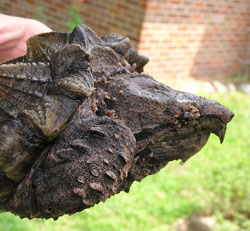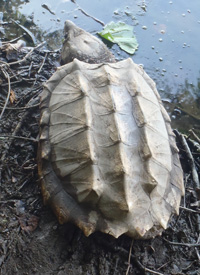 Alligator snapping turtles typically weigh between 155 and 175 pounds. They are the largest freshwater turtles in North America and are characterized by three large, pronounced ridges, or keels, that run from the front to the back of the carapace. With powerful jaws and a large head, the alligator snapping turtle looks very primitive and has been called the dinosaur of the turtle world.
Alligator snapping turtles typically weigh between 155 and 175 pounds. They are the largest freshwater turtles in North America and are characterized by three large, pronounced ridges, or keels, that run from the front to the back of the carapace. With powerful jaws and a large head, the alligator snapping turtle looks very primitive and has been called the dinosaur of the turtle world.
DESCRIPTION
The alligator snapping turtle (Macrochelys temminckii) is one of the largest freshwater turtles in the world, with adults sometimes exceeding two feet in shell length. Maximum weight can reach nearly 250 pounds. Its size and appearance give this creature a prehistoric likeness. The back of the shell is distinctly jagged and the top of the shell (carapace) has three rows of "spikes" or knobs running lengthwise along entire length of the shell. The bottom of the shell is reduced, forming a cross-like shape. Skin coloration ranges from brown to grayish in color, and is lighter on the underside of the turtle. Alligator snapping turtles have large heads with strongly hooked beaks, and the tail is about as long as the carapace. A small, worm-like appendage can sometimes be seen inside the mouth when the creature is agape. This worm-like structure serves as a lure, enticing fish to enter into its open mouth.
 Although alligator snapping turtles are often confused with the common snapping turtle, alligator snappers have a noticeably more jagged shell and larger head. Alligator snapping turtles also have an extra row of scales (scutes) located near the bridge of the shell where the top and bottom meet. The common snapping turtle has only one row of scutes between the carapace and plastron.
Although alligator snapping turtles are often confused with the common snapping turtle, alligator snappers have a noticeably more jagged shell and larger head. Alligator snapping turtles also have an extra row of scales (scutes) located near the bridge of the shell where the top and bottom meet. The common snapping turtle has only one row of scutes between the carapace and plastron.
STATUS
The range of the alligator snapping turtle reaches from southern Georgia, west to eastern Texas and northward up the Mississippi River system reaching as far north as southeast Iowa. The status of the alligator snapping turtle in Indiana is uncertain. Records for extreme southwest Indiana date back to the1800’s, but very few have been taken in the past decades. Alligator snappers were thought to have been completely eliminated (extirpated) from Indiana until one was found in 1991 near the White River in Morgan County. They are considered an endangered species in Indiana.
HABITAT
Alligator snapping turtles seem to prefer deep pools in large rivers, but have been found to occur in bayous, lakes, swamps, and smaller streams.
DIET
The diet of the alligator snapping turtle is variable and may include fish, snakes, salamanders, crayfish, clams, mussels, mammals, plant roots, and birds.
REPRODUCTION
Nesting is thought to take place from April to June, with females laying from 9 to 44 eggs in a subterranean cavity not far from water. The eggs hatch approximately three months later.
LIFESPAN

The alligator snapping turtle has been known to reach 70 years of age in captivity. Little is known concerning the lifespan of wild turtles.
BEHAVIOR
Alligator snapping turtles spend almost their entire lives in water, normally venturing onto land only to lay eggs. While beneath the water’s surface, these turtles are able to use their unique worm-like appendage located on the bottom of their mouth to lure in potential prey. During this process, turtles situate themselves in a dug-out depression, remaining motionless with mouth agape, wriggling the worm-like appendage. Fish finding the "worm" attractive may venture in to become the turtle’s next meal. While these turtles are thought to be less aggressive than the common snapping turtle, the powerful bite of an alligator snapping turtle can be both painful and damaging to humans.
PREDATORS
Juveniles may be consumed by fish, otters, or wading birds; and raccoons have been known to raid nests. The only predator of adult alligator snapping turtles is thought to be humans.
CAUSES OF DECLINE
Indiana is at the periphery of this turtle’s range; consequently, alligator snapping turtles were probably never very abundant in the state. However, they were probably more common in extreme southwestern Indiana a century ago. Reasons for a possible decline in Indiana are not well understood.
MANAGEMENT
The legal protection afforded by its endangered status offers protection for the alligator snapping turtle in Indiana, but management strategies can be difficult

